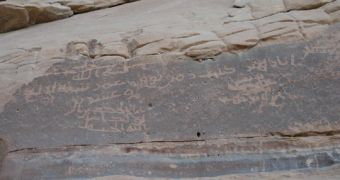A carving made by an ancient Arabic traveler on a red limestone block more than 1,300 years ago may provide new insight on an ardent topic related to the Qur'an (or Koran, as it is better known), the sacred book of the Muslims. Namely, since the inscription contains diacritical marks, it indicates that these kinds of marks were actually in use by the time the Qur'an was written, although the book does not contain them. This aspect, which has been widely disputed for hundreds of years, is now seen in a new light.
The text of the inscription, as it was interpreted by modern scholars, reads, "In the name of Allah / I, Zuhayr, wrote (this) at the time 'Umar died / year four / And twenty". The diacritical marks (accents, umlauts, tildes, cedillas, etc.) help distinguish one word from another, possibly with a completely different meaning. The carving was discovered to the northwest of Saudi Arabia by Ali ibn Ibrahim Ghabban, a member of Riyadh's Supreme Commission for Tourism in the Kingdom of Saudi Arabia, together with his wife, and was dated to 644 AD.
Robert Hoyland, a professor of Arabic and Middle East Studies from the University of St. Andrews, Scotland, explained the importance of the finding for Discovery News, "Whether the Qur'an was originally written in a script that contained diacritical marks is very important because Western Qur'an scholars generally say that it wasn't and therefore feel free to make some amendments to the Qur'anic text by changing the diacritical marks to give it a different meaning, which is, of course, very unpopular with modern Muslim scholars and Muslims in general, who mostly feel that the Qur'anic text they use is the original text revealed to Muhammad by God".
Chronologically speaking, the carving is the first Islamic text found and the second Arabic text, indicating that a marking system was already in place, predating the first Qur'an copies (652-680 AD). This leads Ghabban to conclude that Muhammad's followers "stripped Qur'ans of diacritical marks" so the Muslims would be able "to read the Qur'an as it was revealed to Muhammad in the various dialects of the Arabs, and allowing the skeleton of the word to bear all the meanings which appear in it".
For a better comprehension of the diacritical markings' role, the same unmarked sentence could be both interpreted as "I took with my whole hands," or "I took with my fingertips". The inscription also sheds new light on the time the assassination of the famous Islamic leader Umar ibn al-Khattab took place. As historical data has it, he was stabbed by a Persian soldier while he was amid a crowd attending the caliph's prayers. Perhaps Zuhayr was also there and wrote that it happened in "four and twenty," meaning 644 AD.

 14 DAY TRIAL //
14 DAY TRIAL //